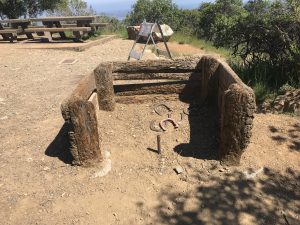Date: 4/26/18
Location: Mount Tamalpais, Marin County
Longitude/Latitude 37.9235° N, 122.5965° W, elevation 2572 ft.
Site Description:
Mt. Tamalpais has beautiful views of the SF bay area, with a high elevation. It has trails full of oaks, redwoods, and shrub growth. It has a good balance of forest areas, chaparral areas and grassland areas. Serpentine rock formations can be found on these trails. Close by is an ampitheater and a small Inn for hikers to enjoy. Species such as the California bay, Madrone, Live oak, and Douglas fir can be found as you climb these trails. Because of the microclimates of Mt. Tam, there is a diverse selection of species found here.
Species Descriptions:
Pictured above is the Mimulus guttatus, also known as the Yellow monkeyflower. It is a California native, part of the Phrymaceae family. It is an annual to perennial herb. Its stem is erect, and its leaves are small simple, abruptly reduced upwards, opposite nodes, ovate to round. It has a yellow flower, with red dots. Green calyx, five unequal yellow lobes. They are a unique species found in many different areas, this was found just off the trail in a chaparral area of Mt. Tamalpais.
Pictured above is Castilleja foliolosa, also known as Wooly paintbrush. It is part of the Orobanchaceae family and is a California native. It has a beautiful vibrant color! My favorite of the trip. It is a perennial herb, with simple alternate leaves. It has a spike like inflorescence, with bracts becoming shorter. It has a calyx that is unequally 4-lobed. It has bright orange bract tips. It has 4 stamens and 2 anther sacs. It is typically found in dry, rocky areas and on edges of chaparrals.
Pictured above is Cirsium occidentale, also known as Western thistle. It is part of the Asteraceae family and is a California native. It is part of the artichoke family, and you can tell from its spikey appearance. It has an erect, branched stem. It has grey basal and proximal cauline leaves, pinnately lobed. It has one inflorescence head in loose to tight clusters, need-like, with a network of cobweb hairs. Its flower is a dark purple, narrowly cylindrical.
Narrative:
We left for Mt. Tamalpais from school around 12:45 pm. When we got there the weather was very warm, and I quickly realized that the turtleneck I wore was a terrible idea. The site had beautiful views and there were many plants there that we had reviewed throughout the course. It was nice to review the things we knew, while also finding some new finds. A random guy on the trail gave our class a bit of a history lesson and some rates on the Inn there, while some classmates were playing with horseshoes. $50 for a bed is all I remember.







